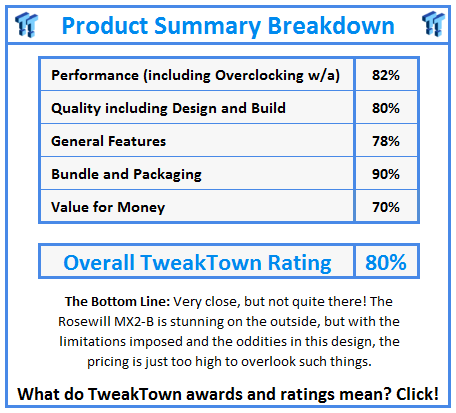Introduction, Specifications and Pricing
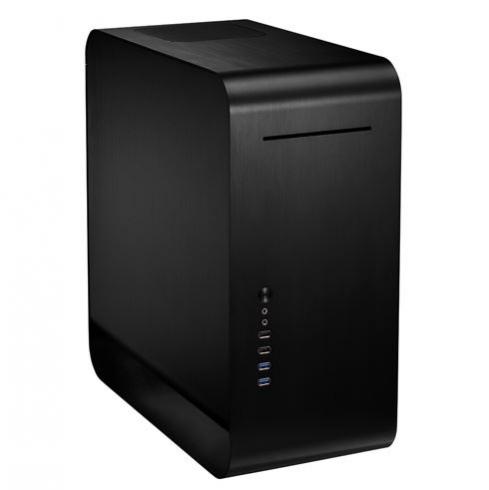
Since we don't see a lot of peripherals and cases from Rosewill, let's start with a bit about them as a company. For those who don't know, Rosewill is the Newegg in-house brand, and when they started this company, there was a very simple idea in mind. Rosewill had the plan to look at all the big sellers in many designs, not just cases and peripherals, and they now pretty much they cover the full gamut of products. Anyways, their plan for success was to get in touch with the OEM manufacturers of products and get their own name on sort of the same idea. The real kicker is that with a bankroll and almost endless room for stock at Newegg, Rosewill is also able to deliver these products at lower price points than the competition.
Going back and checking our records, it has been quite some time since we last saw a chassis from Rosewill. In fact, it goes all the way back to the Thor chassis. It may have been the fact that we stated we had a major meltdown and magic smoke come from our sample, but we also found that Rosewill were very understanding of the issue, and in hardly any time at all, we had a whole new top panel with the I/O shipped to us for replacement of the faulty component.
So, even with a bit of an issue, Rosewill support was top notch and did everything possible to alleviate said issue. To a lot of potential customers, that speaks volumes for Rosewill, as many of the larger "big name" companies may take a week or so even to recognize that they even got an email about the issue. Meanwhile, Rosewill had our replacements here in that time.
The reason we are here today is to give Rosewill a chance to erase past memories as we look at one of their newer cases to hit the market. We are going to be taking a tour of the MX2-B, which is an all-aluminum exterior chassis with steel guts, and a layout that allows for a very compact mid-tower that can still house an ATX motherboard. There is also a sister case to this MX2-B, or black version that we were sent, and that is the MX2-S, which is a silver rendition. There are lots of things to see in this design, and don't let its compact size fool you as there is still plenty of room for components, with some restrictions of course, but by the time we are done here, it will be easy to see that this isn't the "usual suspect" one runs across when looking for a new chassis.
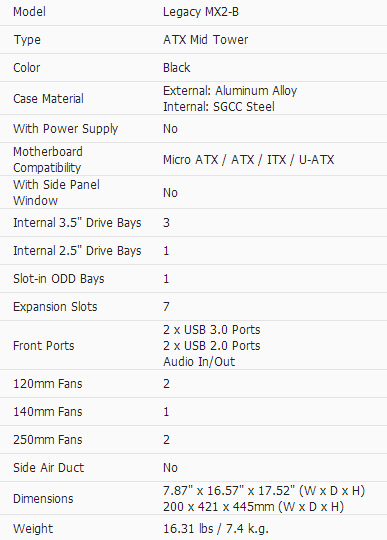
Following the chart past the black Legacy MX2-B ATX mid-tower bit, we see the chassis is made from an aluminum alloy on the outside, while the internals are built from SECC steel and are then painted black to match the exterior of this chassis. It also states there isn't a PSU included, but they should also mention that it is located in the front and can only be around 165mm long to fit well inside of this design. Along with being able to house ITX, M-ATX, and ATX motherboards, there is room for three 3.5-inch drives, a single 2.5-inch drive, and a slot load optical drive. In the back, you will find this chassis offers seven expansion slots, while the front offers USB 3.0, USB 2.0, and HD Audio connectivity.
To cool this chassis, this design employs a chimney effect setup. The bottom of the chassis has a pair of 120mm fans that take air through the bottom of the chassis and push it to the top. It is there that the third and last fan is installed, and they have used a 140mm fan here to exhaust the chassis. There are also two spots in the back of the chassis that will allow for two 80mm optional fans, but the PSU is also something to think about. In this design, the PSU is oriented in an odd way. With no ventilation in the front of the chassis as an option, the fan then faces the motherboard with the plug and switch being what the PSU sits on. So, in essence, this design allows the PSU to exhaust, be picked up by the chassis fan, and sucked back into the PSU fan. Two last notes to consider: the CPU cooler cannot be taller than 150mm, and the VGA overall length cannot be greater than 280mm.
Availability is quite high, and even though this is the Newegg brand, these cases are still widely available at other retailers and should pose no issues in getting one for yourself. What may hinder you from owning one of the Legacy MX2 cases is the pricing, though. While they are showcasing a ton of curved aluminum, and features that the normal tooling won't handle, to get the Legacy MX2-B that we are looking at will set you back very near $200 US dollars. A lot of time with more "exotic" designs, we do find value in what has been delivered, but the bar for testing is also raised, so we will be a little sharper as we look around and build inside of the Legacy MX2-B so we can better assess its value by the time we are done.
PRICING: You can find the Rosewill Legacy MX2-B for sale below. The prices listed are valid at the time of writing but can change at any time. Click the link to see the very latest pricing for the best deal.
United States: The Rosewill Legacy MX2-B retails for $199.99 at Amazon.
Packaging
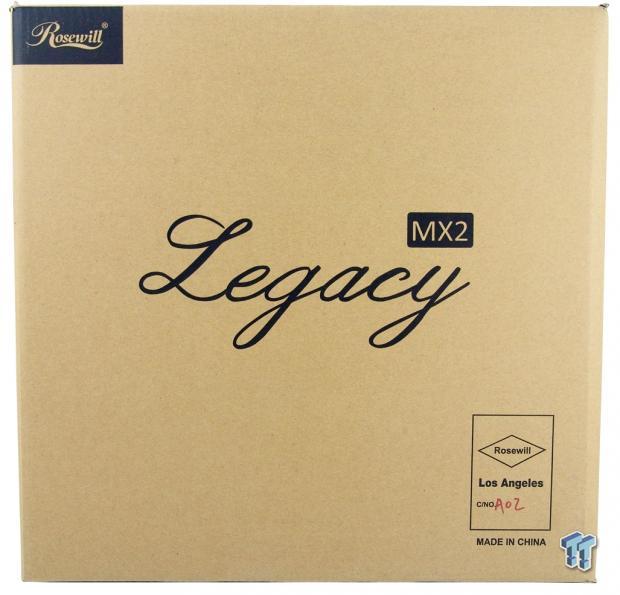
This is what we like to see with an expensive chassis. Rosewill does not go over the top with packaging and employs the KISS principle by using plain brown cardboard and a very simple print applied to the front panel. This leaves customers' money to go into the chassis, not the box.
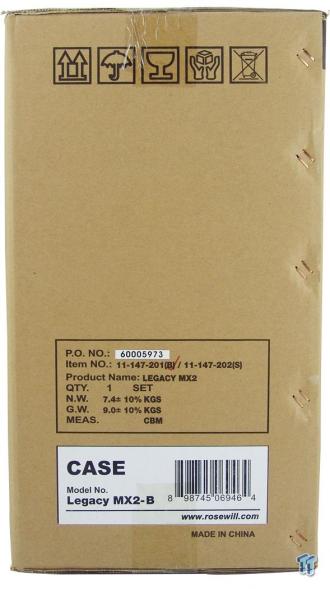
As we spin the box to the left to view the right side, we see iconography across the top, a box with shipping information, and a large white sticker with the chassis naming and web address to get more information on this product.
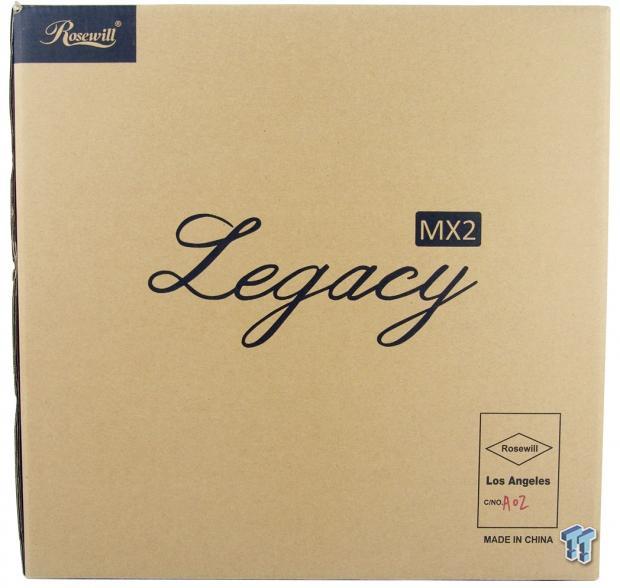
Even on the back of the packaging, they mirrored what we found on the front. They also do a rather good job at hiding what is inside, but with most cases selling in e-tail channels, you have already seen the chassis in images there, so there's no real need to elaborate here.
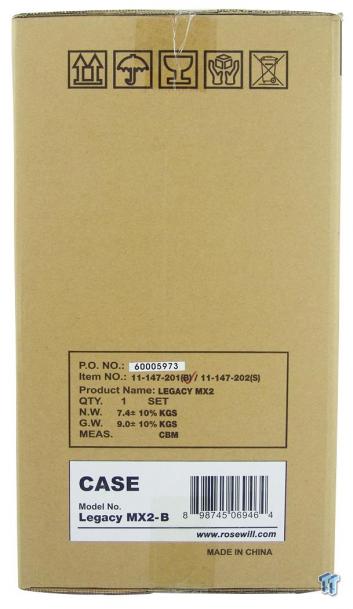
Just like with the front and back panels, both sides match as well, all the way down to the sticker at the bottom.
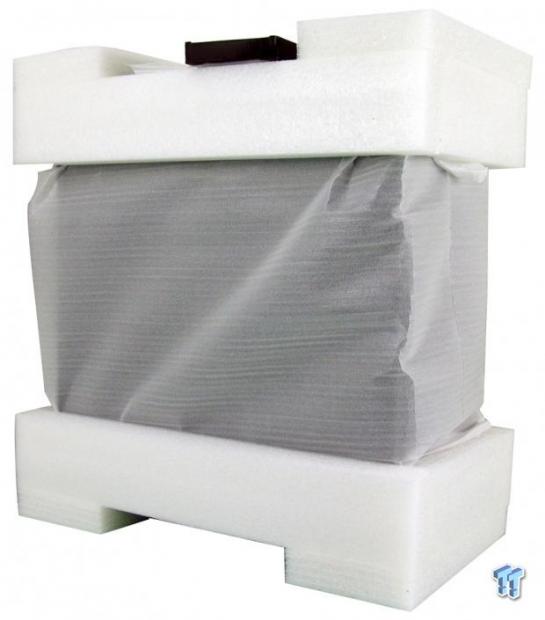
What we really liked seeing with this is that instead of Styrofoam and plastic, Rosewill ships this elegant brushed aluminum beauty inside of a foam liner to protect the finish. They also moved to high density foam to make certain this chassis will arrive in perfect condition as it did for us. If you look on top of the foam surrounding the top of the chassis, you can see the bag for the literature and the black box with hardware in it.
Rosewill Legacy MX2-B Mid-Tower Chassis
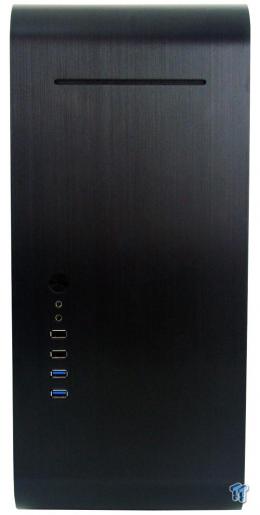
Fresh out of the box, we gander at the front of the MX2-B. Full-length brushed aluminium is what we get, with a slot at the top and the I/O set low and to the left. While both sides are ninety degree corners, as the chassis gets to the top and bottom, the same piece of aluminium gently curves into the top and bottom of the chassis.

The I/O panel offers a metal power button that has a tiny blue LED in the middle of it and a similarly sized red LED below for HDD activity notification. There is a 3.5mm jack for the HD Audio, a pair of USB 2.0 ports, and to finish it up, the pair of USB 3.0 ports.
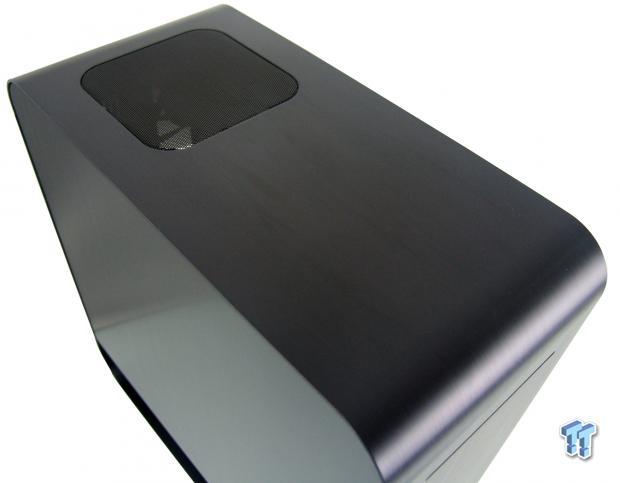
The same piece of aluminum from the front wraps around the corner and becomes the top of the chassis, and it does the same at the bottom. Along with more brushed aluminum to look at, near the back is a mesh panel that gives the 140mm fan a way to vent the chassis.
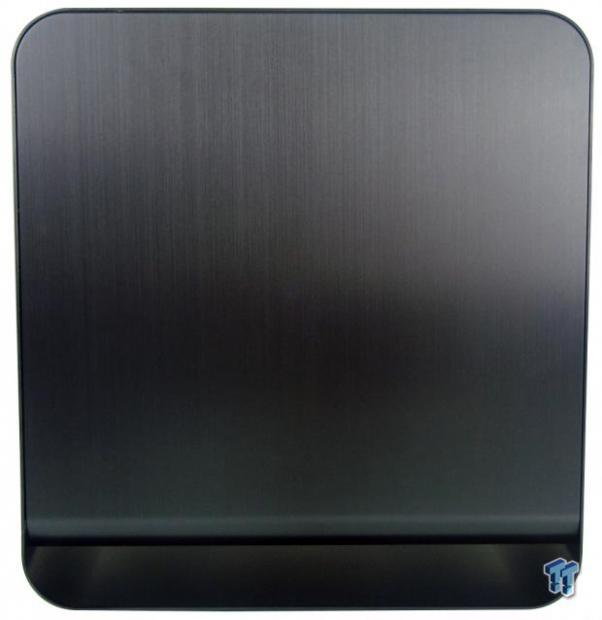
From this view, it is much easier to see how the front, top, and the bottom are all made from one sheet at it rounds off all the corners from this view. The side panel is also plain but, just like the rest of the chassis, carries on with more brushed aluminum, and the cool thing there, is that the bottoms wrap under the chassis to carry the curved theme as well.
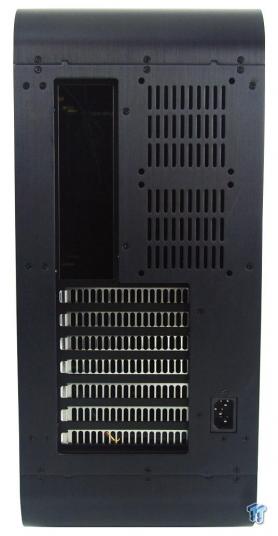
Looking at the back of the chassis, we can see where the main exterior screws into the separated back panel in this design. We also see the rear I/O, a spot for a pair of 80mm fans, seven vented expansion slots, and a PSU socket for the front mounted PSU.
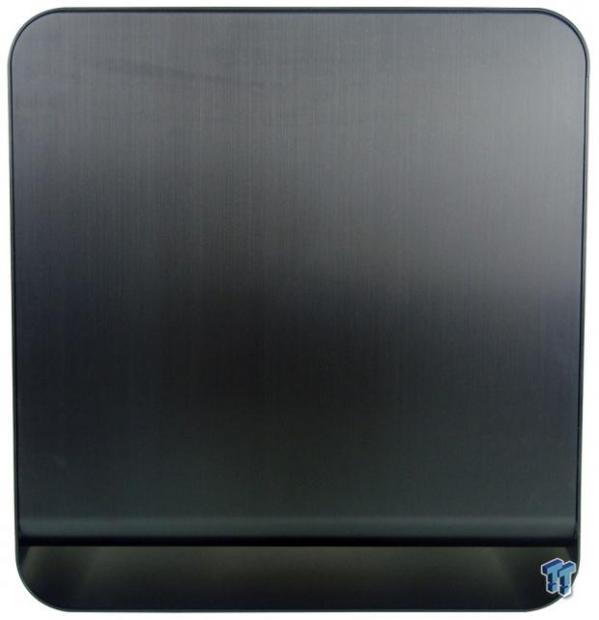
The right side of the chassis is a direct copy of the left side. The interesting thing with these panels is that these panels pop off with a ball and cup system of clips to secure them. No screws are needed, and they do stay in place well, while also being easy to remove for access.
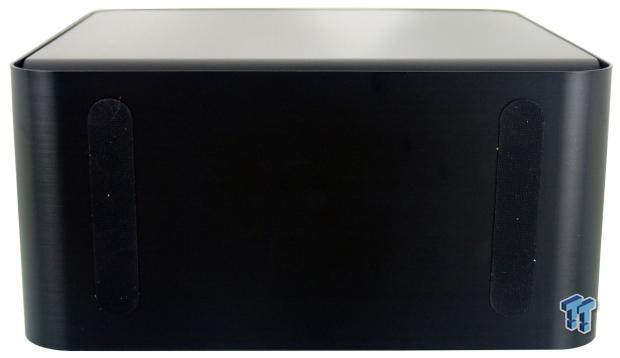
The bottom of the chassis is even a vast expanse of brushed aluminum with two large rubber pads added to it to keep this chassis from sliding around. Also--this is for looks and functionality--the actual floor of the chassis is raised a fair bit to allow the fans and PSU to gather air inside of the chassis.
Inside the Legacy MX2-B
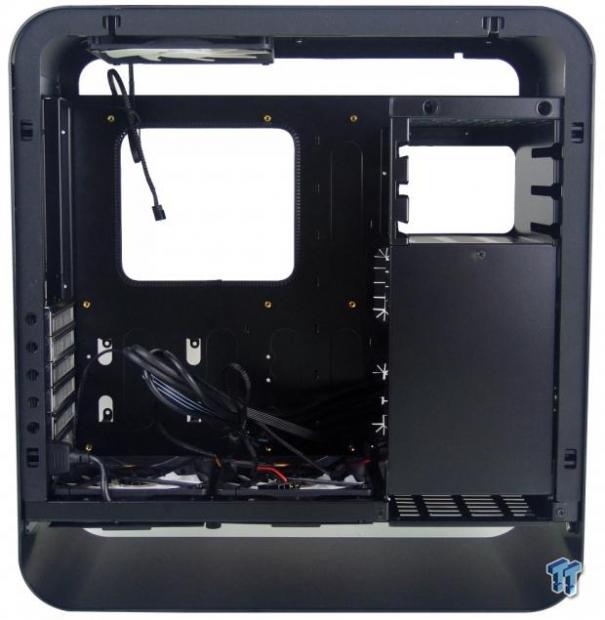
Our first glance inside of the chassis shows the unusual layout that allows this chassis to keep its sleek and elegant exterior while still offering room for an ATX motherboard.

In the front, the bay rack starts off with a single tray to allow for a slot load optical drive. There are tabs on the tray to screw the drive in as well as access holes through the side rails to make life a little easier.
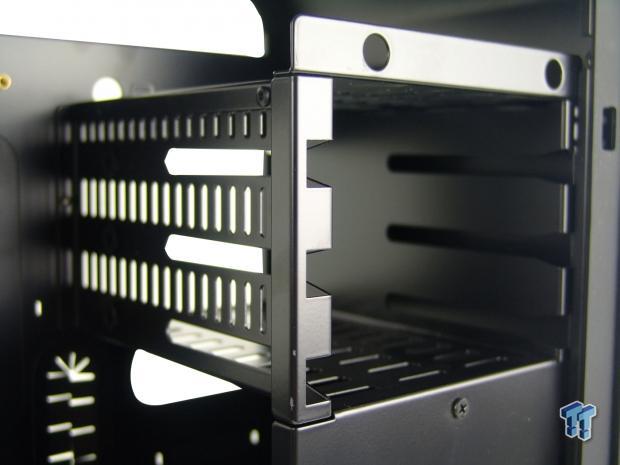
Below that, we have the HDD rack. Here, with help of thumbscrews and grommets put into the holes in the drives, the case allows three of them to be slid in and locked into this rack.
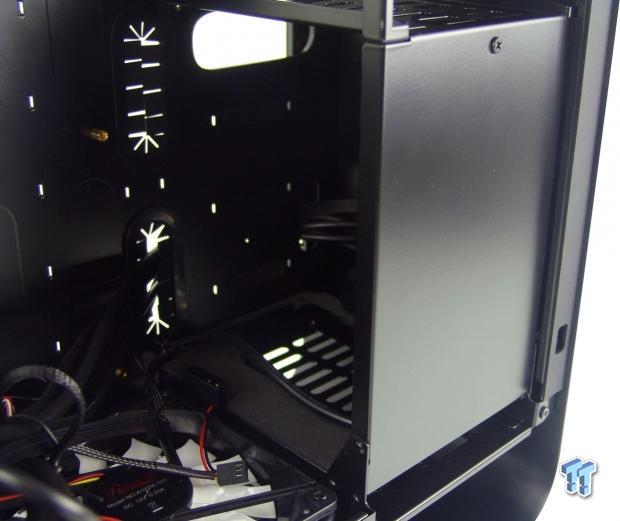
Then, below the HDD rack, there is the tray, which with the removal of four screws, slides out to allow the installation of a PSU.
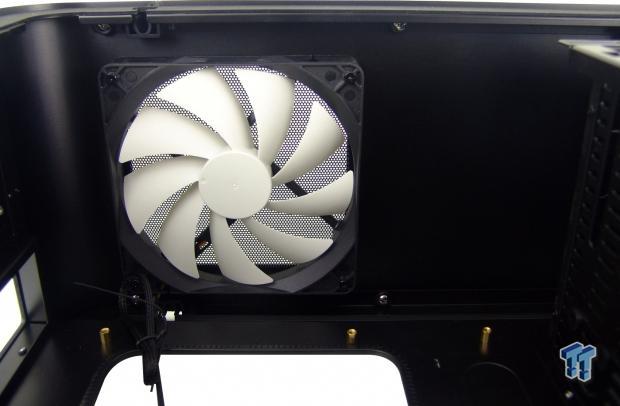
At the top of the chassis, we have the first of three fans that have black frames and white blades, and this one is 140mm in size. These fans all come with 3-pin connections that also have a 4-pin Molex pig tail from the 3-pin.
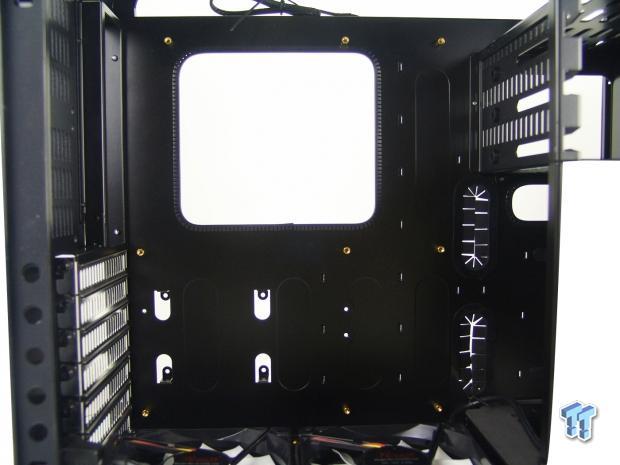
The motherboard tray has the standoffs installed for an ATX motherboard, offers fourteen tie points, and a large CPU cooler back plate access hole with plastic trim around it.
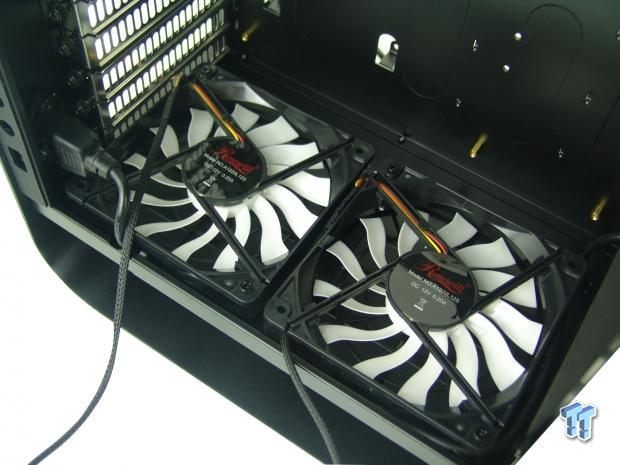
The floor of the chassis offers only room for a pair of 120mm fans. This pair has sleeved cabling and also offers a 3-pin and Molex connection to power them.
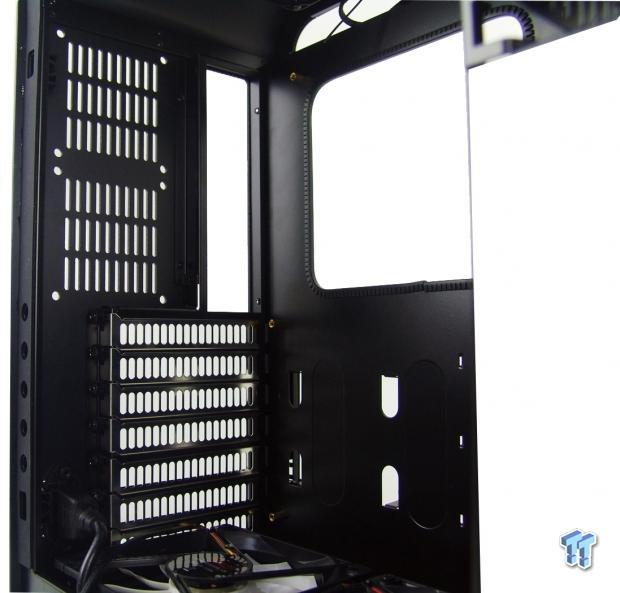
Inside the rear of the MX2-B, we find thumbscrews holding in the expansion slot covers, and while most are very noisy, there is the option to add a pair of 80mm fans to help exhaust this chassis.
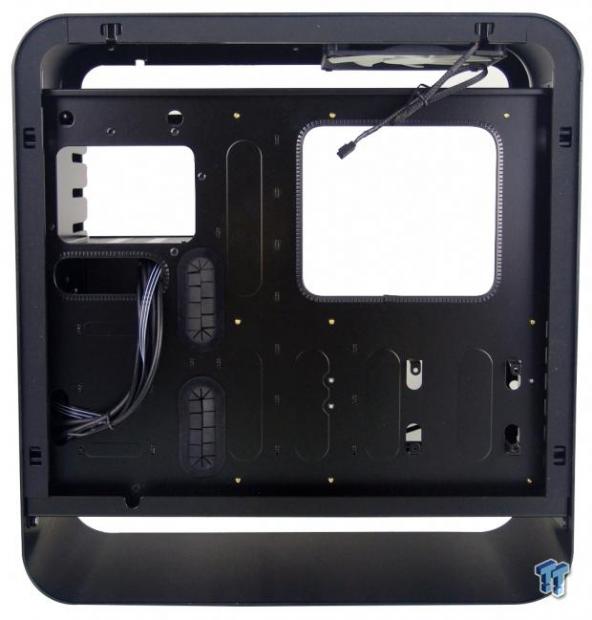
As we look at the back of the motherboard tray, we see the back of the HDD rack is open to wire easily, and there is a hole just below to let the PSU wiring out. A pair of grommets offers ways to get the wiring back to the motherboard along with the whole top edge being open. At the bottom right corner, there are four tabs that will allow a 2.5-inch drive to be installed there.
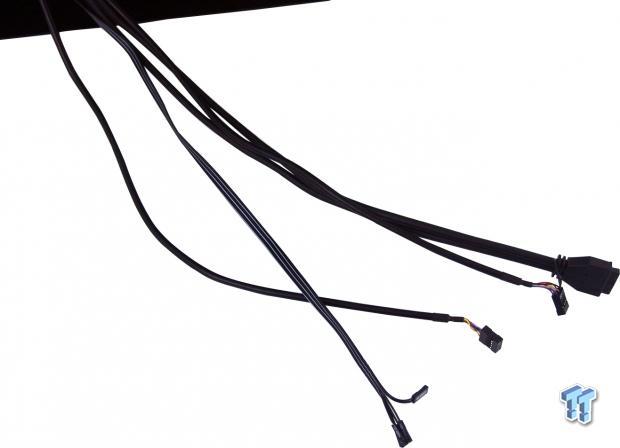
These wires are long enough to get to any motherboard form factor used inside of this chassis. While the grommets in the tray keep most of the switch and LED leads, HD Audio, USB 2.0, and USB 3.0 wiring hidden, what does show is black and blends right in.
Accessories and Documentation
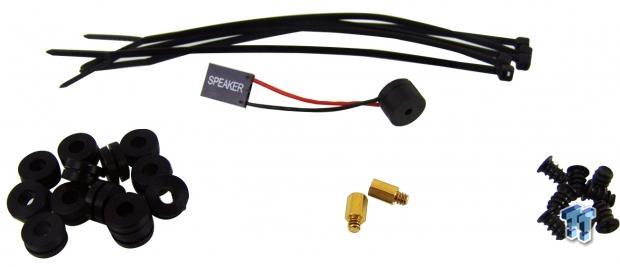
What we see here is half of the hardware offered in that black box. There are five zip ties, a motherboard post speaker, thirteen rubber grommets to use with storage drives, a pair of extra standoffs, and a set of eight regular fan screws.

The chassis offers the option to use the thumbscrews or the flat head screws to their right to mount the 3.5-inch drives, with a small set of screws to be used for the 2.5-inch drive. The bottom row offers paper washers of all things, motherboard and PSU screws in the middle, and a set of five screws for the slot load optical drive to the right.
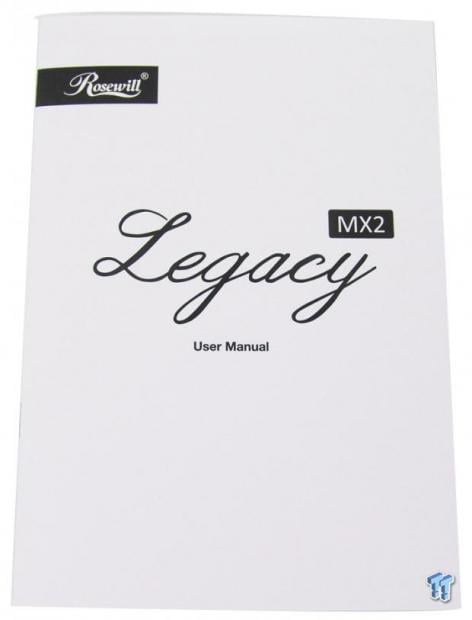
Even the cover of the manual is pretty plain, just like the packaging. Just like that, the inside is where all the good stuff is, and Rosewill explains how to get the doors off, shows all the hardware and what it's for, and goes through and explains as well as shows how to install components so that even the novice builder can successfully complete a build.
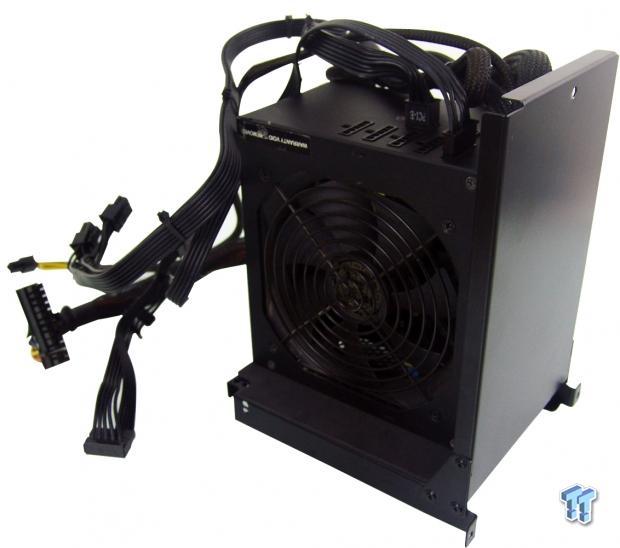
This is, of course, the slide out PSU tray. With a thick foam pad at the bottom for the PSU to rest on, it is somewhat isolated from the rest of the chassis. However, this tray was either out of square, or my PSUs are, because we had one hell of a time forcing the PSU into this. We also found out that usual PSUs won't fit; you need to be sure to have something shorter to allow the wiring to be slid in as well.
Case Build and Finished Product
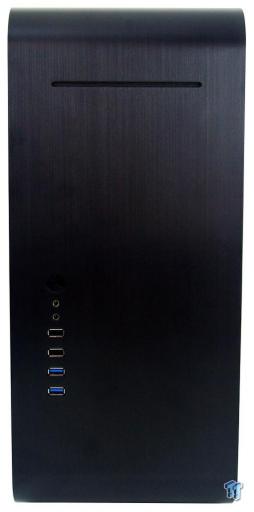
The nice thing about the MX2-B is that even when the build is completed, that sleek and simple look that we started with is exactly what we have when the build is finished.
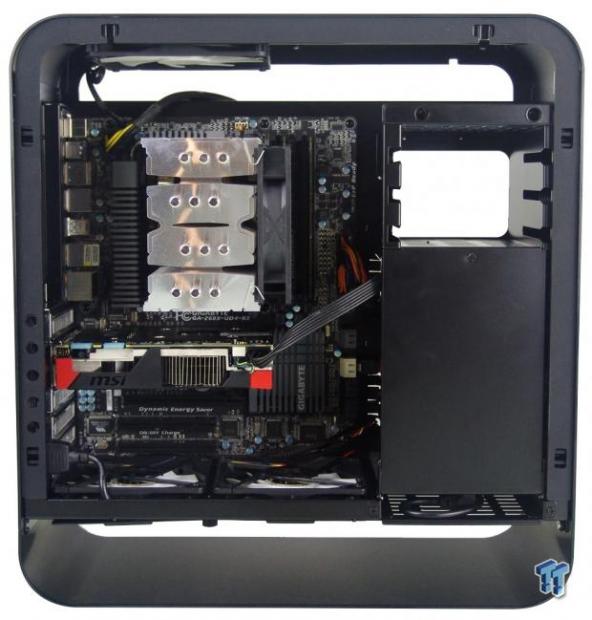
We had to be selective of the CPU cooler used, and we also had to go with the mini-card as the HD7950 is definitely too long. While cramped, the only real issue we had is that the native USB 3.0 port is blocked by fans, rendering our ports useless.
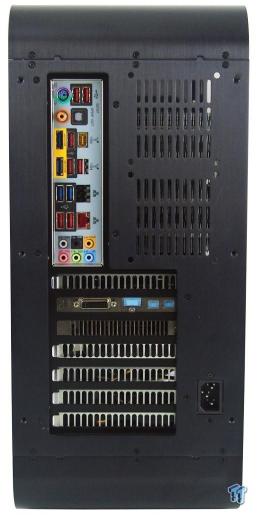
The dust shield for the rear I/O panel went in just fine, but we did have to flex the back panel to get the holes to line up with the bracket on the VGA, but in the end, it was sort of worth it as at least it sets level across the chassis.
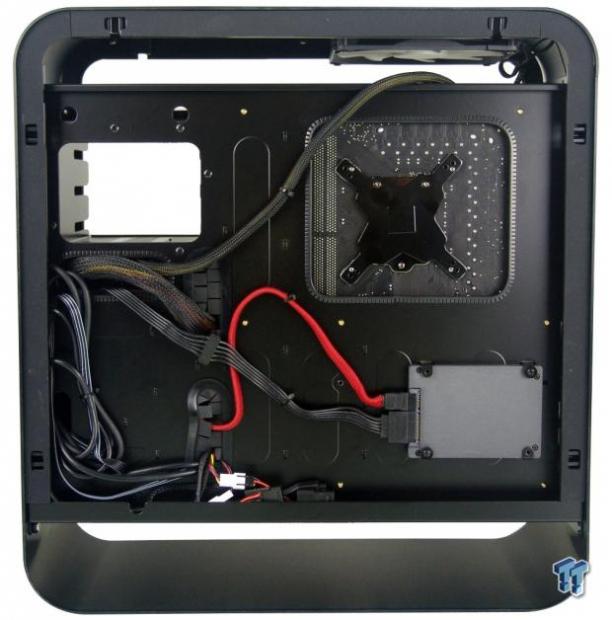
At first, we had thought we would run into wiring issues, but in reality, it isn't that bad at all. Of course, we did not maximize the capacity of this chassis, and that would involve more wiring, but we are pleased with being able to hide what we did.
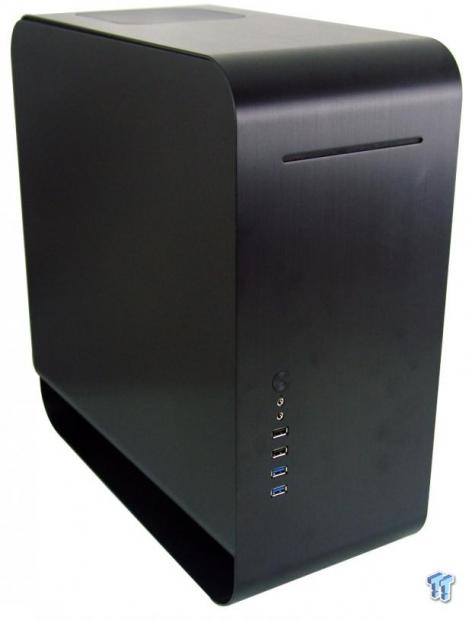
Once the panels are back on the sides of the chassis, we are back to square one as far as its aesthetic appeal with a completed build inside. That is something that is not lost on us, and we can appreciate this in almost any environment from the professionals to the newest amateur gamer.
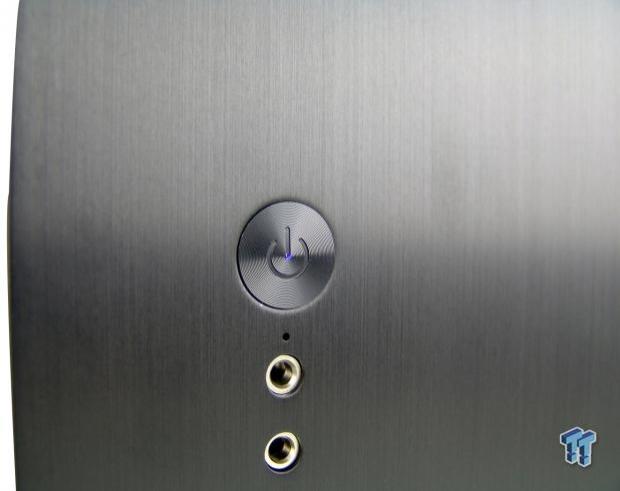
We did miss the very fast flicker of the red LED to signify the activity of the SSD, but you can see the blue LED that will be on whenever the chassis is powered on. Outside of these tiny LEDs, you have to get real close to the chassis to hear anything substantial to realize it is on, and that leads to the 27 dB noise level we recorded at a foot away from the top exhaust; otherwise, it will be hard to hear in the average room.
Final Thoughts
While we did run into some issues in this design, one could be a one off example where the PSU tray was deformed in just this instance and not something that every chassis would see. Thing about this is the guy who put it into the chassis had to know something was up, as it was forced in and very tough to remove. Considering the rest of the chassis has no damage to mention, we hope this isn't something plaguing every chassis. As for the USB 3.0 issue, that is more because of the parts we use to test. Some motherboards have that header on the right side and not across the bottom, and as long as you choose parts wisely, the fan blocking the USB 3.0 header can be remedied.
Our major obstacle with this design is the PSU. There isn't a way to vent through the front of the chassis, so we put the fan facing the motherboard. Well, in this setup, even if the fan were to be flipped around to the front, the fans in the bottom were just cycling its waste. This also led to slightly warmer thermal results inside of this chassis than we expected with the chimney-like flow of air this chassis is supposed to offer.
It is hard to deny the sleek look of the brushed aluminum, the curved front wrapping around the top and bottom, and the side panels offering the same curve at the bottom of them. The Legacy MX2-B is definitely unique and attractive on the outside. As we moved inside, while a slot load optical drive is not something everyone owns, three HDD bays and an SSD bay were plenty of room for our storage needs. While most CPU tower style coolers may wreak havoc on closing the side panel, there is room for an AIO on the floor, or even a 140mm version hung from the top. In the end, the biggest thing to keep in mind with the Legacy MX2-B is that this is not a chassis you simply migrate your gear into; there is a lot of planning and shopping for just the right parts to complete this build. That puts this chassis into a more niche group of users, since the more novice builders won't pay attention to all the limitations and offerings the Legacy MX2-B limits you to.
With availability high, it is the price that also adds to the niche market we find the MX2-B to be in. Near $200 for a mid-tower chassis is a tough pill to swallow, and we feel that this chassis, while stunning in its looks and compact design, is pricing itself right out of many potential customers' hands. Unless you have the need for this specific chassis, or are just a sucker for brushed aluminum, compact, and silent cases that will likely be for only one build, then by all means go and grab one.
At this price, even taking into consideration the tooling, R&D, and uniqueness against the masses of cases on the market, it just does not offer that longevity people want at this price range, and with the limitations imposed, this isn't really for the power users either. For the office, or a more professional environment where this will be on display, and you need an elegant way to surf the net and answer emails, this may be right up your alley. Given a little more thought into the design, and some minor tweaks, we could really back this chassis, but as it sits, we just don't see it.
PRICING: You can find the Rosewill Legacy MX2-B for sale below. The prices listed are valid at the time of writing but can change at any time. Click the link to see the very latest pricing for the best deal.
United States: The Rosewill Legacy MX2-B retails for $199.99 at Amazon.


